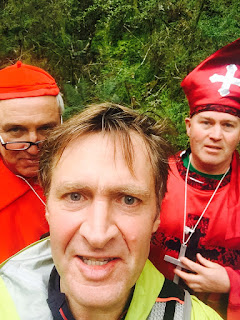The Kepler is over for another year, this my second time
running this superb race.
These are some thoughts on what to expect running the
Kepler, for those that haven’t yet had the privilege. And I do think it’s a privilege to traverse
this track, one of New Zealand’s great walks.
It’s what brings me back to it, together with the amazing community
spirit from the people of Te Anau that wraps around it.
As a runner, this community spirit displays itself in the
aid stations, which for some of them have become performance art. This year we had hippies, Where’s Wally,
Santa and the Papal Curia. We had a
group of well-wishers that had camped out on the side of the lake to cheer us
on has we turned up the hill towards Luxmore.
We had groups of locals that had gathered at the points in the track
that can be accessed from the road or water.
All full of smiles and encouragement.
And it lifts you. Excellent
effort Te Anau.
I think of the race in five parts. The first is the gentle trail around the
lake, with the sun reflecting off the glistening water. The second is the climb through the forest up
to Luxmore Hut. The third is the alpine section
over the tops. The fourth is the drop
down into Iris Burn. The fifth, the
longest, is the second half of the race past Lake Manapouri and down the valley
to the control gates at the finish.
My key tip at this stage is to change into warmer gear
before you hit the alpine section above the tree line. I put on a long-sleeved top, my parka, my hat
and gloves. Once over the tree line it
can feel like you have stepped into a fridge.
This year the wind wasn’t too bad, but with wind chill it was approaching
zero degrees. The previous time I did
the race, I got changed after I realised it was cold, and spent ages shivering
and fiddling around trying to put on my gear.
The third part, across the tops, is honest mountain
running. You are almost certain to have
your bag checked for the compulsory gear at Luxmore. The trail becomes narrower and gnarlier, with
snow and ice patches this year to contend with.
It didn’t feel all that treacherous this year, but if the wind gets up
it feels quite different.
 It’s pretty clear when you are on the tops that you need decent
trail shoes. There were quite a lot of
runners that were using normal road running shoes and the lack of grip would
have been unnerving for them on this stage.
Plus, you are smacking into rocks from time to time and need toe protection.
It’s pretty clear when you are on the tops that you need decent
trail shoes. There were quite a lot of
runners that were using normal road running shoes and the lack of grip would
have been unnerving for them on this stage.
Plus, you are smacking into rocks from time to time and need toe protection.
The race website says the vertical is about 1.3km, but my
Suunto suggests it was closer to 2km. It
felt more like 2km to me.
The fourth part is the drop down off the alpine section into
the tranquility of the valley below.
The trail is basically pretty smooth in this section, which allows you
to open up a bit on the descent, flowing into the switch backs with a good
racing line.
 The one thing I would say about the aid stations is the food
is basic. You really just have oranges
and bananas, which means you need to carry all the supplemental nutrition to
get you through the race. Oh yes, they
also have jelly airplanes. But there are
lots of aid stations, around 10. This
means you are never much more than 60-90 minutes from an aid station. This means you don’t have to completely fill
up on water and so carry less weight.
The one thing I would say about the aid stations is the food
is basic. You really just have oranges
and bananas, which means you need to carry all the supplemental nutrition to
get you through the race. Oh yes, they
also have jelly airplanes. But there are
lots of aid stations, around 10. This
means you are never much more than 60-90 minutes from an aid station. This means you don’t have to completely fill
up on water and so carry less weight.
The final, longest, part is the 30 odd kilometres down the
valley to the finish. This could best be
described as meandering, rolling terrain.
The track is very good and you can get a rhythm going. It is beautiful, alongside the river, but there
is not much variation here. Just drop
into a meditative state and power through to the finish.
Just before turning into the finishing straight, a guy
approached me with a film camera and asked what I thought of the race. I said I really loved this race and appreciated
the warm support on the trail.
It’s such a special race in a special part of the
world.